How to write the perfect ‘welcome’ email
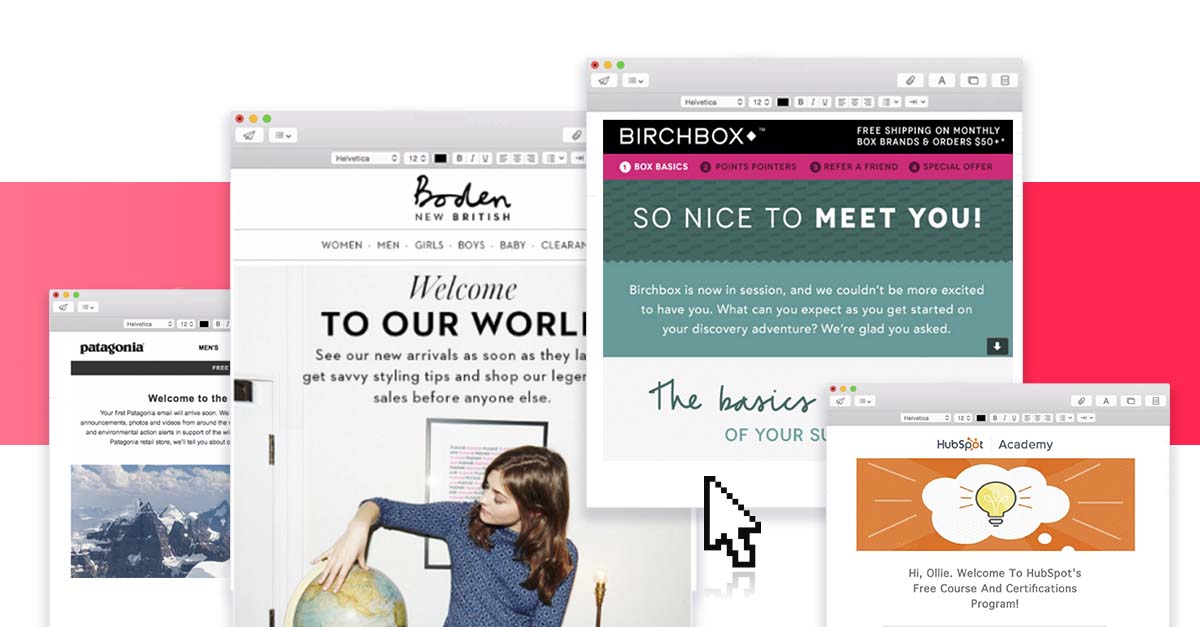
How much emphasis do you put on creating a great welcome email for your new subscribers?
They may not be the most exciting weapon in your marketing toolbox, but compared to other marketing emails, welcome emails generate four times the open rates and five times the click throughs.
It’s easy to get lost in the bright shiny lights and vanity metrics associated with list building, website traffic and social media engagement. But email marketing still delivers a significantly higher ROI than any of those channels, and your welcome email is your only chance at a first impression.
Your welcome email is perhaps the most important message you communicate with your audience, because it lays the foundation for what’s to come. It reinforces the decision someone just made to give you their contact information. It ensures that from that day forward your emails get opened, read and clicked on. It’s the difference between an effective email marketing strategy, and a database full of disengaged space-fillers.
I get it, for most businesses the number one goal is to get new customers quickly and generate a high return on investment from your marketing. And a lot of the time that lends itself to direct response marketing and paid ads.
But with the ever-increasing expectations of today’s consumer for information and trust before purchasing, you don’t have any choice but to nurture them first before making a sale. Email marketing gives you an opportunity to accelerate the trust building process, and your welcome email is the first step.
To get you started here are 14 tips, plus examples, for creating the perfect welcome email.
1. Ask them to do something
It’s estimated that the average person gets 121 emails every day. People are in inbox overload.
That means that email clients such as Outlook and Gmail are getting considerably tighter with the emails they let into people’s inbox, in an attempt to improve user experience.
For businesses, this means that one of the biggest digital ROI generators is now getting harder. More and more you will find yourself turning up in someone’s “Promotions” folder or even worse, their “Junk”.
There are three specific things you can ask prospects to do in your welcome email that will have you turning up in the inbox from day one:
- Whitelist your email
- Add the email to their favorites folder
- Reply to the email
These three things are sending trust signals to their email provider and decreasing the chance that you will bypass their inbox next time around.
Here is an example of the team at Digital Marketer doing this in their welcome email:
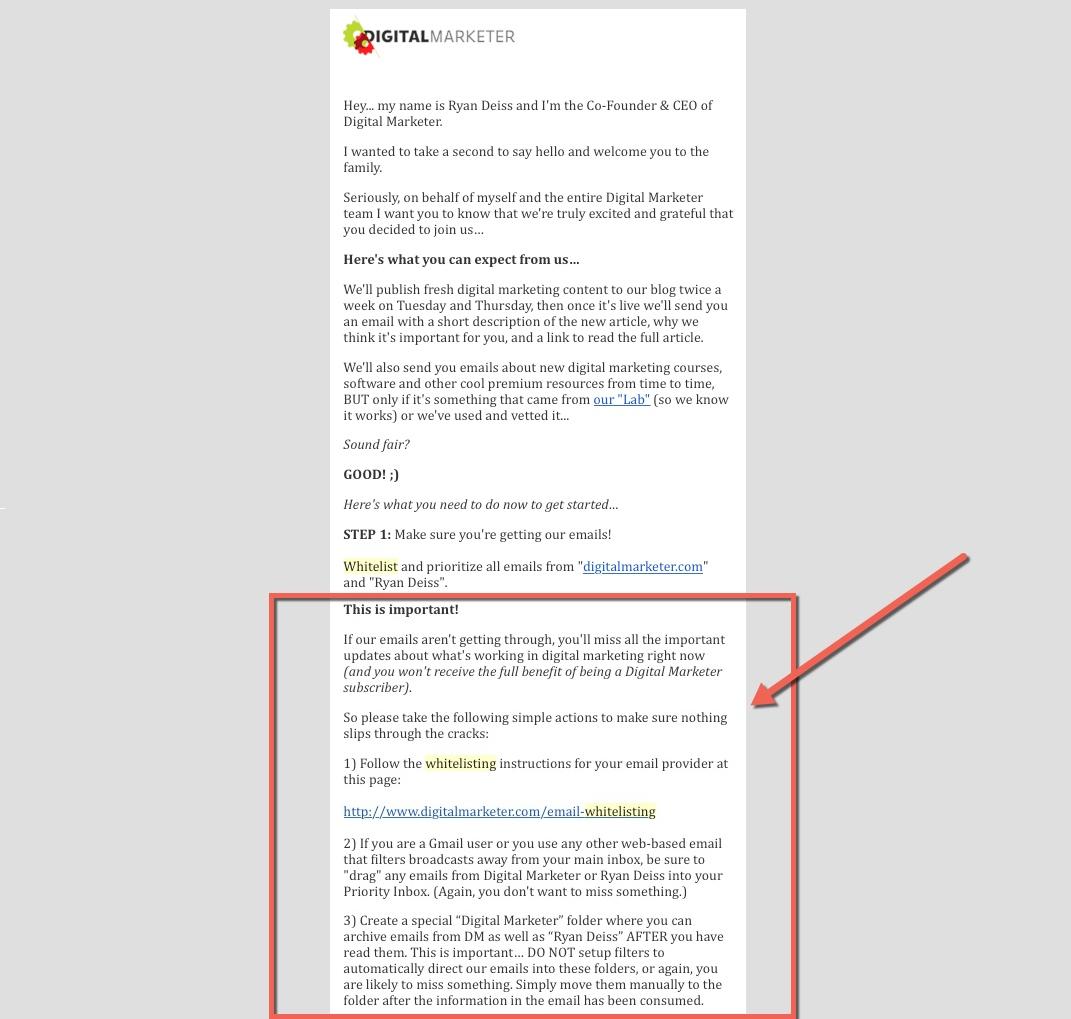
Image Source: Digital Marketer
2. Remind them why they signed up
Reinforcing the reason why someone just signed up for your email list can be a great tactic for getting some immediate engagement.
One way you can do this is to offer a “Perks List”, telling your subscribers what they should expect and why signing up for your company’s newsletter was a great idea.
In the first example below, Flood Magazine’s welcome email clearly explains who they are and what their magazine’s about.
They also tell their newsletter subscribers that they’ll receive “all the best shows, events, contests, and content that your hometown has to offer – right to your inbox. We do the heavy-lifting and you enjoy the rewards.”
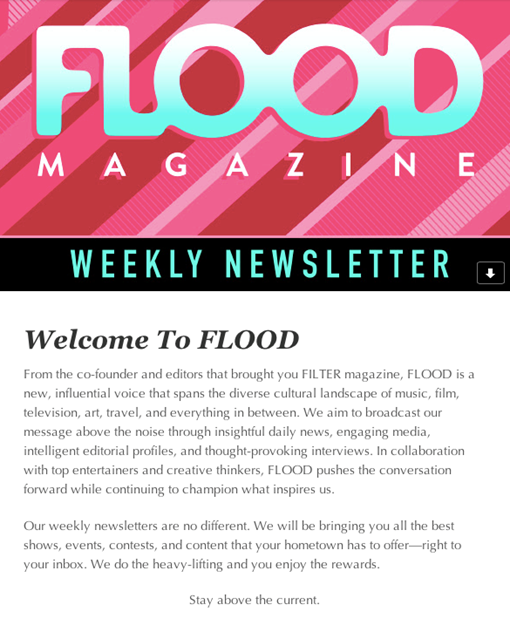
Image Source: Flood Magazine
In this welcome email from the National Football League (NFL), they offer five benefits to new subscribers in the form of a bulleted list, just above a big, shiny “Shop Now” button.
Subscribers will not only receive 10% off their first order and a bunch of other perks, but they’ll also be able to shop conveniently from their device. That’s a really great welcome!
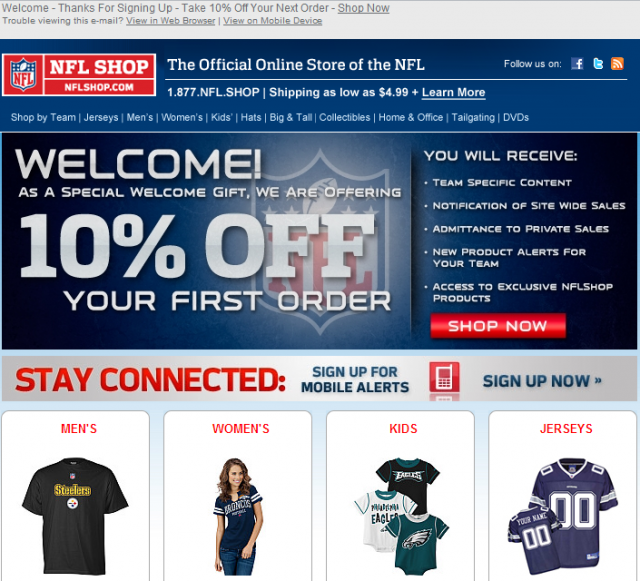
Image Source: National Football League (NFL)
3. Make it timely
According to a Ciceron Report, subscribers are the most engaged within the first two days of subscribing.
When prospects sign up to your company’s list, they should get a welcome email soon after – ideally within the first 24 hours. If you wait for even a few days, they may lose interest and this will result in lower engagement rates.
So that you know how important timing is, look at the chart below from Return Path’s study, The Email Subscriber Experience. It shows the number of days that many marketers choose to send their welcome email after someone signs up.
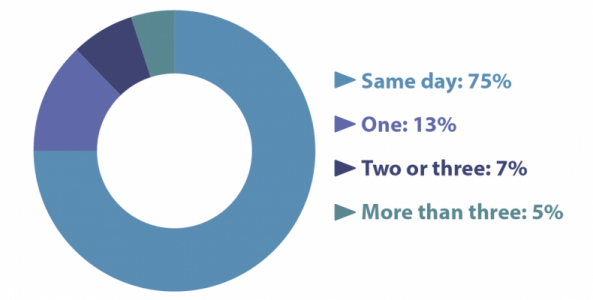
Image Source: Return Path
You can see that 75% of marketers sent welcome emails on the same day someone subscribed, because time is of the essence.
When it comes to your email provider, choose one who’ll enable you to send a timely, automated welcome email.
4. Use a clear and engaging subject line
A boring subject line can result in your welcome email getting lost in the clutter of someone’s crowded inbox and left unopened or worse, deleted.
To make sure that your prospects open your welcome email, use compelling language in your subject line.
Welcome emails perform best when they’re clearly identified with the word “Welcome” in the subject line, but they should also grab your prospect’s attention and compel them to find out more.
Overstock do a great job of this, with a subject line like “Welcome – 12% off Coupon on Your First Order”:
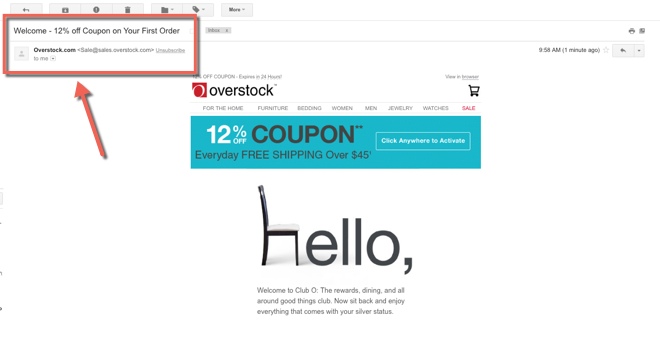
Image Source: Overstock
And so do Ann Taylor, “A Gift To Welcome You To a.t.FIRST”:
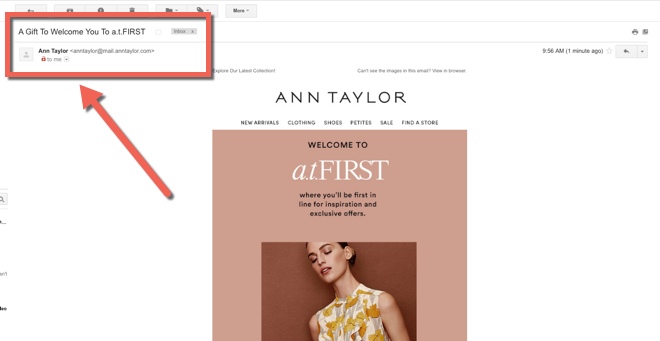
Image Source: Ann Taylor
Other words you can use in your subject line to increase open and click-through rates are sale, thank you, new, news, daily, weekly, alert, bulletin and video. Any type of personalization can work wonders too.
5. Personalize your salutation
It’s important that you make your greeting more personal to new subscribers. For example, if part of the sign-up process includes the collection of subscribers’ names, then why not use them in your welcome email?
Welcome emails with 1:1 personalized greetings or subject lines are 26% more likely to be opened.
Here is an example of HubSpot Academy doing this in their welcome email:
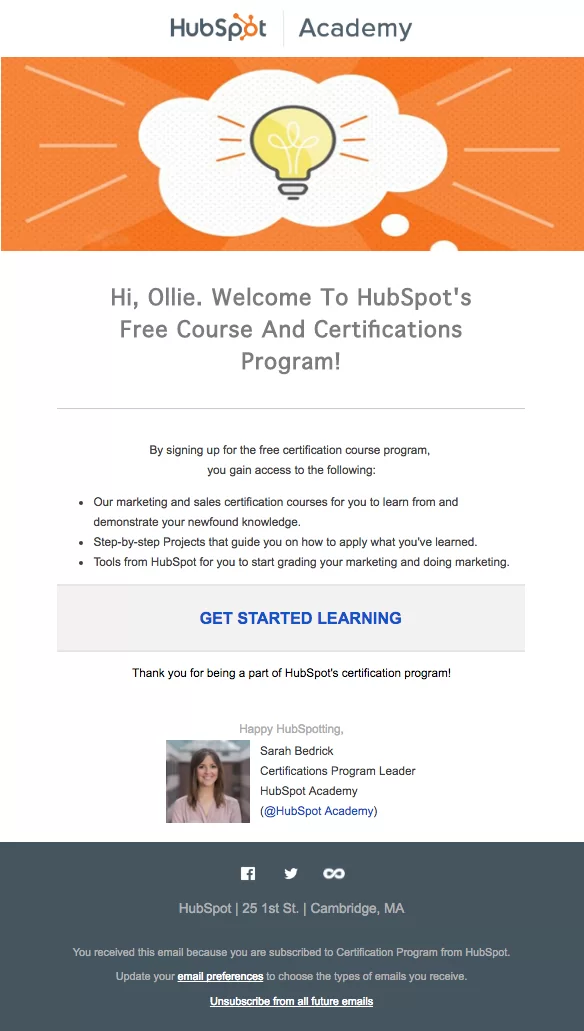
Likewise, if you requested additional information from your subscribers, such as their interests, goals, location, business type, and so on, also use these to further personalize your welcome email.
You can take things even further by sending your welcome email from a staff member and including their email address. This gives a human touch to your email.
In the example below, Vero’s welcome email comes from Chris Hexton, the company’s co-founder and CEO.

Image Source: Vero
6. Say thank you
A welcome email needs a warm and personal introduction that greets new subscribers and makes them feel that they’re now a part of your family or team.
You can do this by saying thank you to your new subscribers for signing up to your company’s newsletter, either in the subject line or in the copy of the email.
For example, you can write “Thank you for subscribing. It’s our pleasure to welcome you to the XYZ Company Email Club.”
In this welcome email from David’s Bridal, the company thanks new subscribers for making them a part of their wedding day.
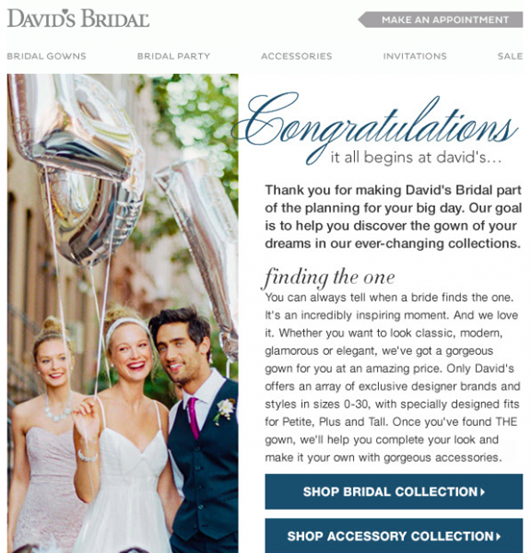
Image Source: David’s Bridal
In Kate Spade’s welcome email below, the words “Thank You” are written in big, bold letters on the back of an envelope, making it both welcoming and personal.
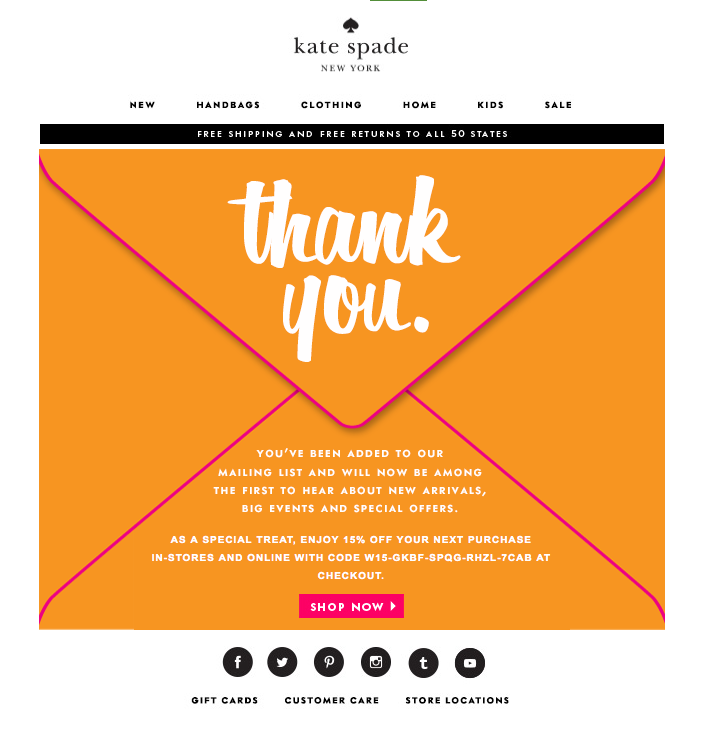
Image Source: Kate Spade
There’s no right or wrong way to say thank you to your new guests, just ensure that it’s conversational and fits your company’s voice.
7. Use brand consistent visuals
Shining the spotlight on your company and your products or services with eye-catching visuals is a must. But whatever visual content you want to include in your welcome email, be it an infographic, photos or videos, it’s essential that they’re consistent with the image of your brand.
Welcome emails need to look like the web pages from where they came. Brand consistency across all your media channels helps build a strong impression of your company in the person’s mind.
The welcome email of Bellamy’s Organic is a great example of this:
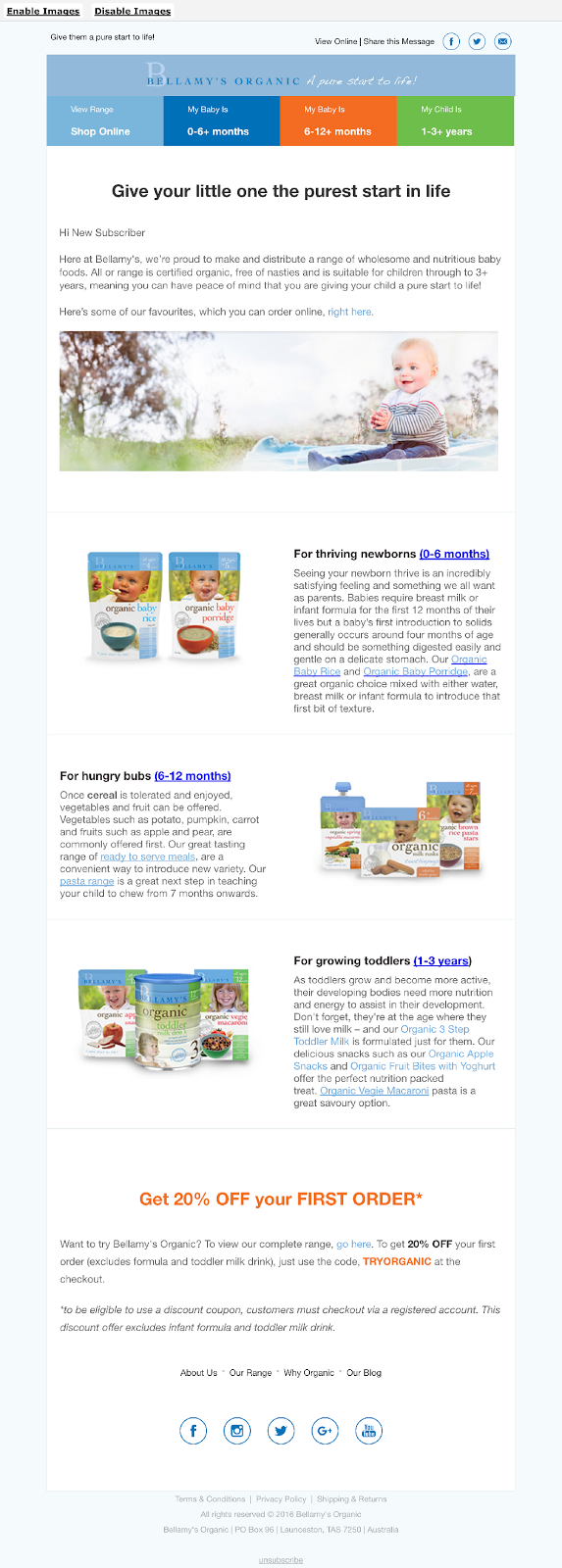
Image Source: Bellamy’s Organic
If your company is a service-based business or a non-profit organisation, use compelling or emotion-evoking images that relate to your company.
Try spotlighting a successful and happy customer, including a photo of your team or volunteers (people love a warm welcome from your staff members!), or displaying before and after pictures.
You can also try using clean, flat, simple graphics and complementary colours, just like Birchbox does in their welcome email below:
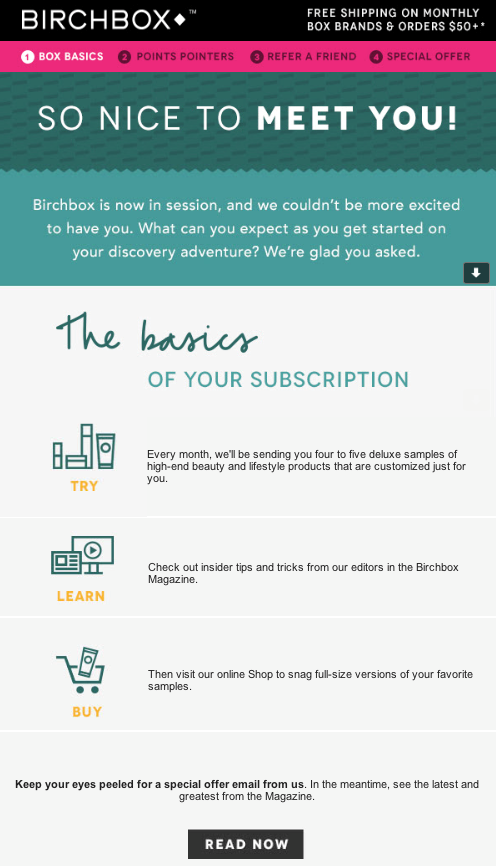
Image Source: Birchbox
8. Keep it simple
With the knowledge that welcome emails achieve a higher open rate than other types of marketing emails, you could be tempted to include many different promotions and calls-to-action to increase your chances of converting your prospects into customers.
But including too much content in your welcome email could actually result in people choosing to ignore it, so keep it short and simple.
Your welcome email should have a simple design, a concise message welcoming new subscribers to your mailing list, and a brief description of what they could expect to receive in the future.
Threadless’ welcome email, as you can see here, has all these elements plus four different calls-to-action. But the information is presented in a concise manner, making for a short, engaging email.
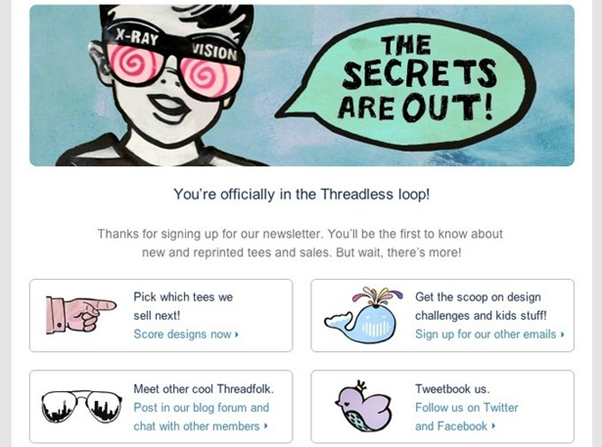
Image Source: Threadless
If you’ll be including visual content, make sure to use visuals that are easy to digest, like an infographic, compelling images or a video, and maintain a ratio of one paragraph of text to each image or video.
9. Tell them what they can expect from your emails
In your welcome email, set out exactly what your subscribers can expect to receive from you and how often.
For example, tell your recipients that they’ll now be kept up to date with the latest fashion news and exclusive offers, as well as the frequency of the emails.
Mr Porter’s welcome email, shown here, lays out the exact terms of service:
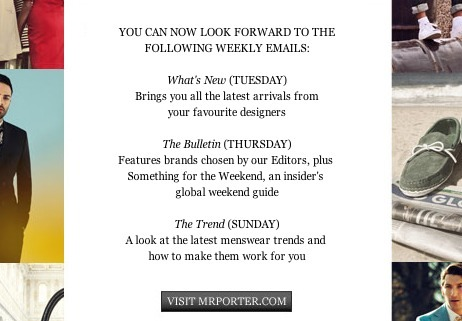
Image Source: Mr Porter
Your welcome email should also give your prospects the option to change the frequency of your emails or turn them off completely.
Flickr’s welcome email below clearly states “we will notify you by email when there is activity related to you on Flickr. You can customize these emails or turn them off at any time.” The links provided make it easy for the new subscriber to change the email frequency.
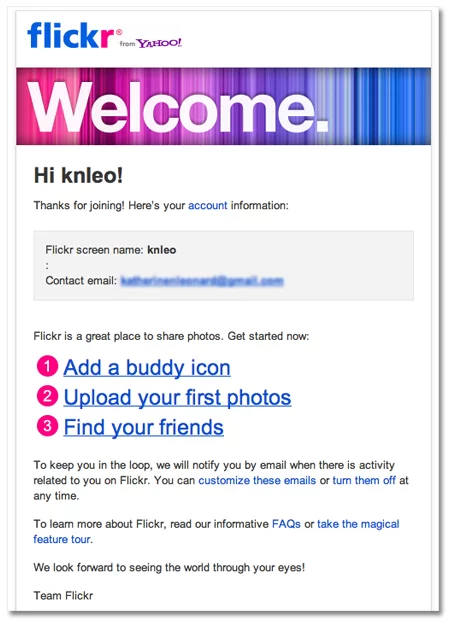
Image Source: Flickr
When people sign up for a service, they might not realize that they’re also signing up for email marketing. Ease this email tension by setting realistic inbox expectations. This transparency helps build trust and establish a positive relationship.
10. Give them a gift
You can create goodwill between your company and your prospects by giving a free gift or offer such as a discount on the first order or some exceptional free content.
It could even make your subscribers consider buying from you and coming back for more, as welcome emails that have incentives and discounts lead to 2.6 times the transaction rates.
The offer should have a clear call to action that stands out and seems urgent or time-sensitive.
Use complementary colour schemes, a button instead of hyperlinked text, and catchphrases like “Shop Now” and “Buy Now”.
As you can see here, Crocs’ welcome email has a 20% off promotion with two bright green buttons to “Shop Now”.
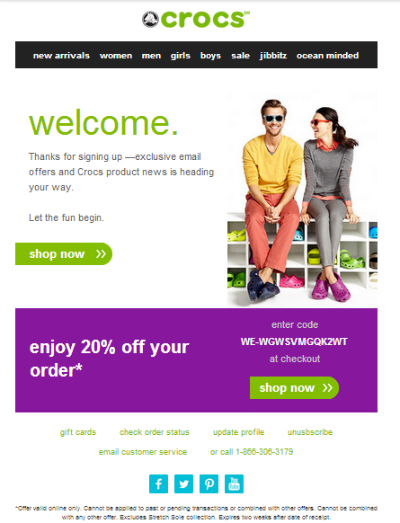
Image Source: Crocs
On the other hand, the welcome email from GAP offers $15 off your next purchase of $75 or more.
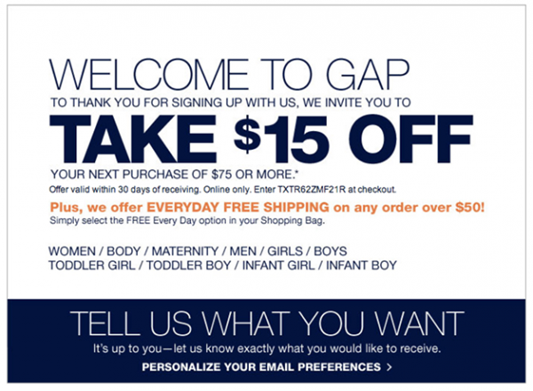
Image Source: GAP
You can also offer both a discount code and recommend some of your best products at the same time to make it easier for your prospects to look for a good product.
11. Get them to follow you on social media
New subscribers will be curious about your business, so fuel their engagement by including links to your social media sites in your welcome email.
This could come in the form of social media buttons, connecting to your company’s Facebook or Twitter page, Instagram account, LinkedIn profile, and so on.
This allows your prospects to share your message with their family and friends, and to further connect with your organisation.
Take a look at House of Fraser’s welcome email below, where in the bottom right corner you’ll see links to the company’s blog and Twitter and Facebook pages.
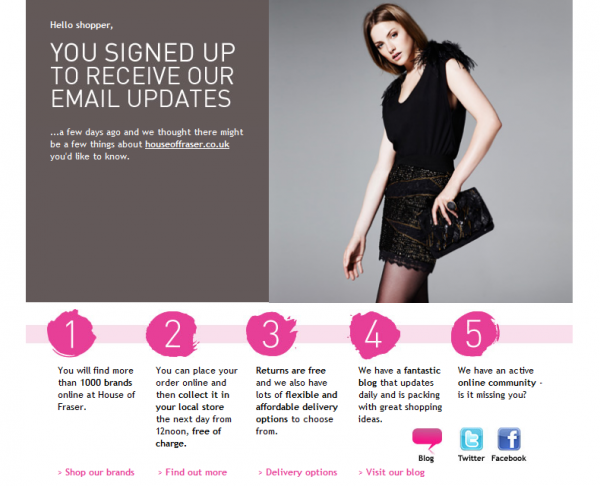
Image Source: House of Fraser
It’s good to give your prospects more ways to get in touch with you and interact with your company. But it’s even better to come out and ask them to follow your business.
Here’s an example of Food52 doing this in their welcome email, with the confirmation page encouraging new subscribers to follow their brand on Facebook and Twitter.

Image Source: Food52
12. Ask for a friend referral
Friend referrals can be a powerful way to build your email list. Referred email subscribers are often more engaged than subscribers from other sources.
Because when a friend recommends something to you, it carries far more credibility than any online ad or content you happened to stumble across on the web.
While you may not get a lot of new subscribers from your referral requests, the ones you do end up getting will most likely be of high value.
A small list of highly engaged subscribers can be just as good, or even better, than a big list of less engaged subscribers.
Boden’s welcome email, as shown below, does this really well. It has a link in the footer, encouraging subscribers to refer a friend in return for a $15 discount.
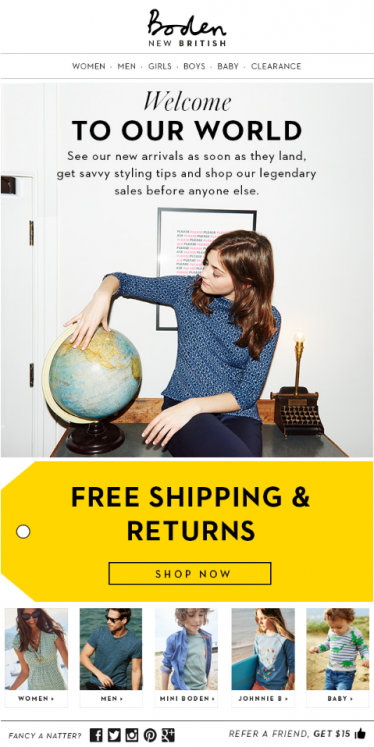
Image Source: Boden
As you can see, asking your subscribers to refer a friend is an easy way to grow your audience organically.
13. Make it easy for them to contact you
Tell your prospects how they can get in touch with your company and who to contact if they have any questions or want to give feedback.
Even if you’re asking someone to respond to a question in your welcome email, you should still provide customer support contact information.
Leave your welcome email with an open offer to assist your subscribers.
You can write something like:
- “If you have any questions, you can reach me personally at (your work or mobile number) or give me a shout at (your email).”
- “If you’d like, someone on our team can talk you through it. Just reply back to this email or give us a call at (your work number).”
- “I’d like to introduce you to (name of person) who I have cc’d in this email. They have many years of experience in the field. They’ll be your main point of contact here at (your company’s name).”
Patagonia’s welcome email has a section titled “We’re Here to Help” and they encourage new subscribers to reach out any time for assistance. This can be done simply by clicking on the “Contact us” link.
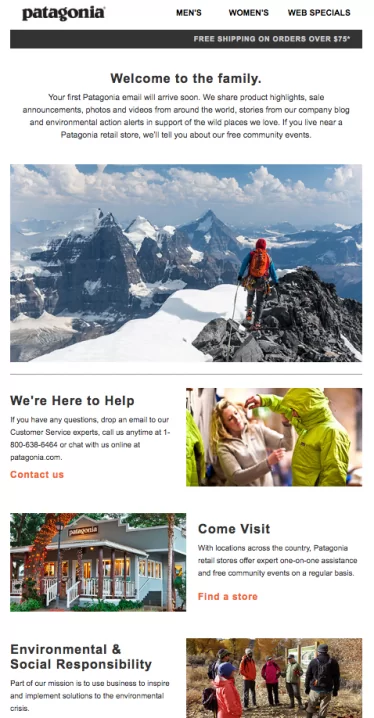
Image Source: Patagonia
14. Offer an unsubscribe link
Even as you welcome your new subscribers, you also have to give them the option of unsubscribing from your emails at any time.
This is not only a legal requirement (in accordance to the Spam Act), but an email marketing campaign best practice. Not conforming to the unsubscribe facility means potentially being labelled as “Junk” or “Spam” by major email providers such as Gmail and Outlook, which can affect the deliverability and success of all future email sends from your business.
So, given offering an unsubscribe link is a must for your welcome email, it’s in your best interest to do it well, with a bit of style and perhaps a bit of creativity.
This welcome email from the San Diego Chargers has a one-click unsubscribe link in the footer, with simple and standard implementation to match the simple design of the email’s body.
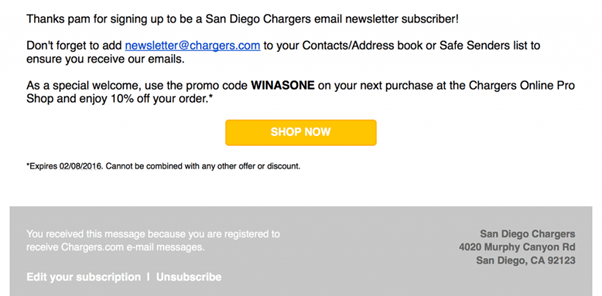
Image Source: San Diego Chargers
Here’s another example of a welcome email, from Typeform, that offers subscribers the option to unsubscribe alongside a personal touch: “If you’d rather not receive these tips and tricks on how to get the most out of Typeform, you can unsubscribe here. We’ll be sad, but no hard feelings.”
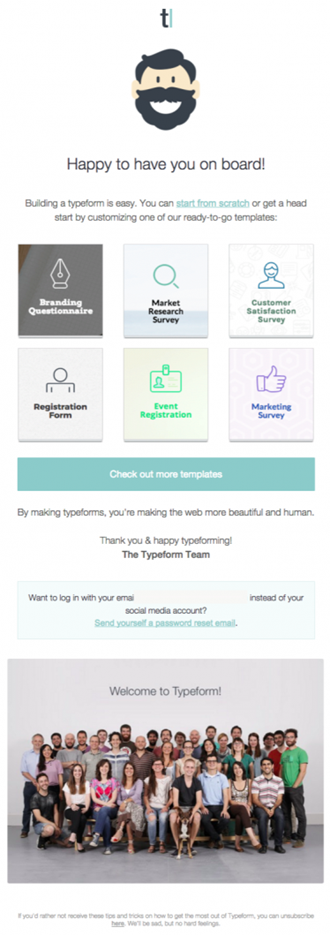
Image Source: Typeform
If you want to get into your subscribers “Inbox” folder, don’t forget to offer an unsubscribe link in your welcome email.
Key takeaways
Incorporating a well-crafted welcome email into your digital marketing strategy is an important part of attracting and retaining new customers.
Acknowledge a prospect’s subscription, tell them what’ll happen next, and then affirm that they have a place in your community.
And remember, great welcome emails are more than just thanking someone for subscribing and giving them more info about your company and your products or services. They make people feel excited about joining your community, and start the nurturing process of a lifetime customer relationship.
Have we missed anything? What elements do you include in your welcome email?





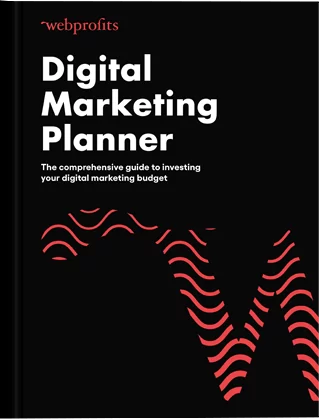
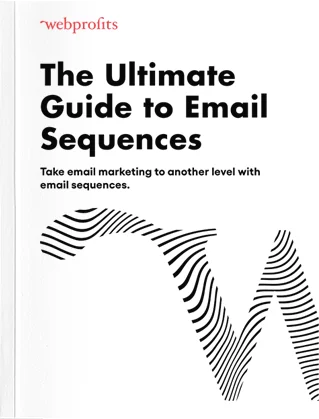
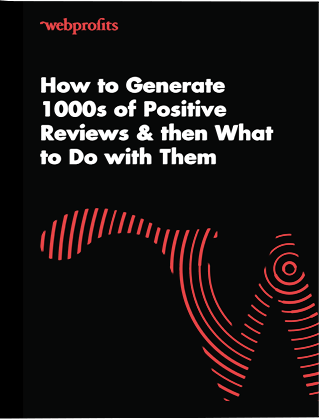
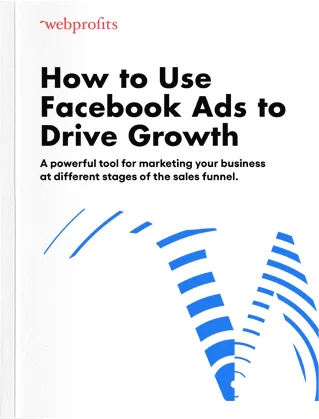
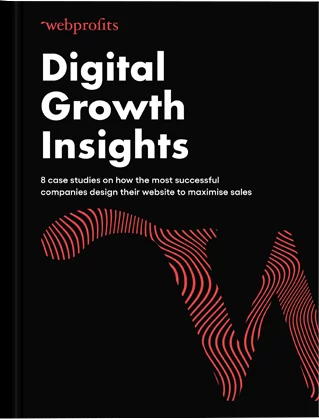
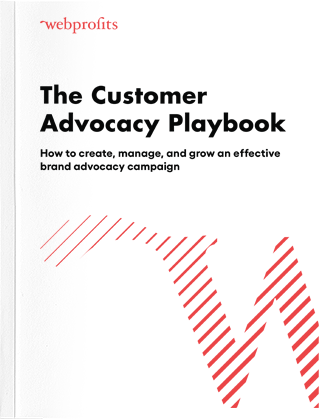
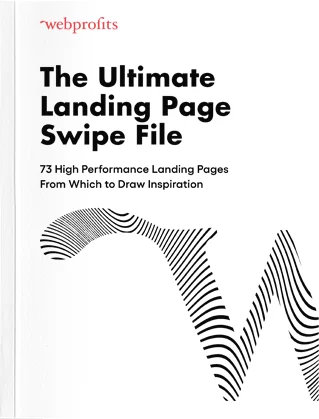

[…] mine that data for insights and ideas. Use their first name wherever and whenever possible. Send a personalized welcome email after they sign up or make their first […]